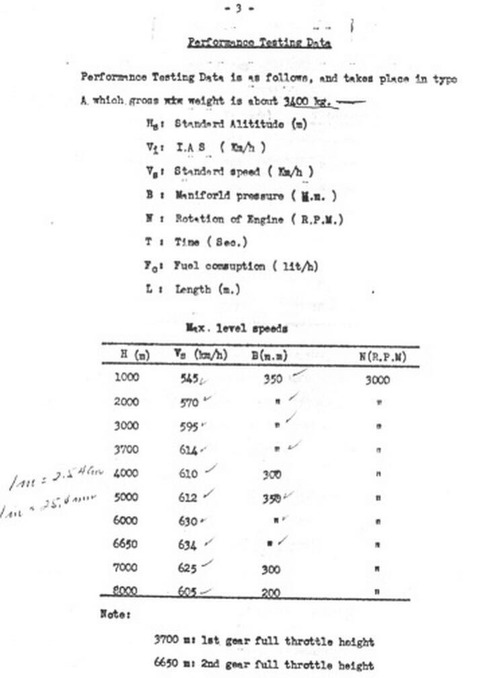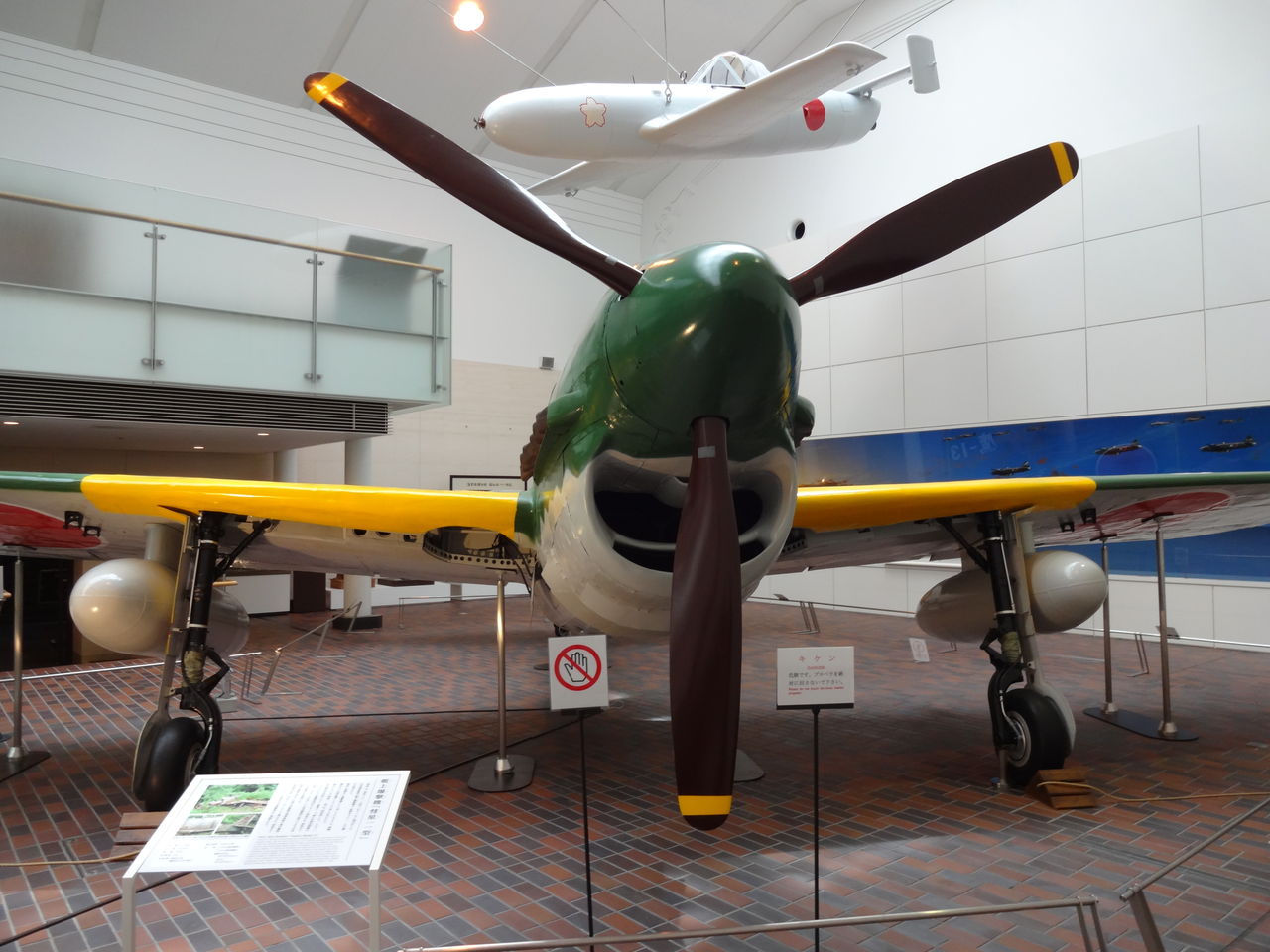TAIC 687kph at 1850hp at 20000 feet doesnt seem anything out of ordinary to me.
F8F-1 does 698kph at 1850hp at 20000 feet.
Is Ki-84 really that much draggy than F8F-1?
Also this document is from Aug 1945 and states:
So they had a flyable ki84 before the end of the war and probably when the TAIC was done.
Clark Air Base was recaptured in January, TAIC dates as of March.
Hi,
I'm aware that TAIC had flying Ki-84s during the war. However, this calculation was done by March 1945 as written in the TAIC Manual. It's quite doubtful that any comprehensive max performance test was performed on a captured Ki-84 by this time, and the TAIC manual makes no note that it is derived from real data.
In terms of the drag, I can't really give an answer because I don't have this data. But as an aside, I would say that it is quite likely the F8F had superior propeller design than the Ki-84, which is often cited as a regret in Japanese books.
If you have speed and WEP power charts for the F8F, I'd like to see them if it's no problem.
Furthermore, the TAIC figures for the power @ alt of the Ha-45-21 seem to be based on early targets. The Army/Navy data often gives a 2nd speed full pressure mil-power alt of 20,000ft/6100m and mil power of 1620 metric HP (1600 HP) at this alt. Whether this power was reduced by a lower CR or not is hard to say.
WEP figures are rarely published in Japanese sources, but the WEP full pressure alt will be below 20k ft in that case.
In general I am averse to using a calculation, especially because we can't verify exactly what factors went into it, and it's far from the existing Japanese data at full rated power. I'm hoping there are other Japanese tests yet to be uncovered.
Thanks for the informed rely. I've read your analysis before and very much enjoyed your thorough discussion of the topic.
There are a few things that I'd point out:
So getting back to TAIC and Middleton (MAMA) testing standards, the information that we're missing is the Homare 21 bench testing under controlled conditions. Do you have access to these documents? There are two AFAIK, one relating to the controlled bench test and one relating to the aircraft evaluation. AFAIK, these are the documents that Greg is primarily referencing and they are absent from your website's analysis. They've been linked to multiple times on this forum.
I linked the reports used in the video a few posts up. The Middletown report doesn't have a cover page, so perhaps I cited it oddly, but I have been using it.
The Middletown report doesn't include any flight performance other than the basic handling characteristics and the brief mention of climb performance that I posted above.
The 1946 engine overhaul text is included in the report, however the power specs given are simply a copy of the TAIC figures from early 1945 or before:
The actual overhauled engine was bench tested just up to 2900 rpm +470mmHg, but there's no power results given.
There are a few points that need to be made:
First, WW2-era pitot tube speedometers aren't always accurate due to differences in wind, heat, humidity, altitude, airflow over the tube, and other variables that can't be controlled for. So TAIC is likely testing engines in isolation, outside of aircraft, in order to avoid two issues. The primary issue is standardization and the secondary issue may be cost. However, Greg doesn't speculate as to why TAIC's engineers used controlled external bench testing conditions to generate the synthetic speed estimates of the Frank, but it's cheaper and it's more standardizable to run the engine up on the ground and then synthetically generate its top speed.
In fact, TAIC basically states in the beginning of their intelligence reports that they do not calculate speed in the air and that all calculations, unless otherwise stated, are done synthetically. But that said, their report on the Homare 21 is actually one of the most thorough and comprehensive reports available on a WW2 engine, according to Greg.
TAIC had no choice but to make estimated calculations for the max performance of Japanese aircraft. It simply wasn't possible to actually test most newer types, and captured planes were often unflyable, or not outputting their intended performance, safe to do so, or so on. The Ki-84s captured in the Philippines were likely subjected to restricted operating conditions even if they were in good conditions.
An actual flight speed test will always be more accurate than a calculation, but it wasn't possible or practical.
In the speed video IIRC he states that he thinks the T-2 Report (TAIC) numbers were an actual performance test. It's an easy assumption to make because it's labeled 'factual data', but it seems certainly to be calculated estimates.
Second, Greg also gets into the 624 KPH numbers and explains why they're not as authoritative as MAMA's data. Basically, those numbers aren't as well understood as the Middleton data. Again, the Homare Ha-45-21 that was tested at Middleton was removed from the Ki-84, completely disassembled and rebuilt to the factory standard (likely using machined components if such components were bad on the original engine). The engine was then tested at Middleton WITHOUT an aircraft attached to the engine using 96 octane (so the issue with knock disappeared). Because it was run with 96 octane, the dash 21 was run at its maximum horsepower using full RPMs and manifold pressure. In other words, this was not indicative of an aircraft flown in the Philippines or Japan, where the majority of air combat occurred. There were only three synthetic fuel factories that could produce 100 octane fuel under Japanese control IIRC. One in Manchuria, Korea, and Taiwan. So if there were Frank fighters capable of similar performance, they would have likely been outside the major zones of conflict (except Taiwan). It's possible that some better conditioned Franks were flying in the 1944 Japanese offensive in China, but IDK.
I don't think the climb data similarity is proof that TAIC's information is incorrect. If it is incorrect, or a result of a patchwork methodology, it would take an aerospace engineer to figure out where the mistake occurred. We lack the calculations used by TAIC and only have their final analysis. Is it possible? It is, but we don't have authoritative data or primary sources to confirm that point. At present, we only have (thanks to your work) a working hypothesis that suggests there might be a mistake in their calculations. However, I believe that the MAMA report might shed additional light on this incongruity.
The 624km/h number is pretty well understood in Japanese sources. It was a mil-power performance test done with one of the initial prototypes with Ha-45 Special (Ha-45-12) which is weaker than an unrestricted Ha-45-21. I'd say it's authoritative, but only for that context.
If you meant the 634km/h 'fully rated' data, I agree that it's not well contextualized, but it's still more tangible than a TAIC estimate in my perspective.
Middletown data does not exist in the report used. There is no flight speed performance given in that report. The other T-2 report just has TAIC's calculated estimates, as explained.
And the output of the engine is not provided in the Middletown report, just TAIC's power numbers from early 1945.
The fact that we lack the data that actually went into TAIC's calculations (apart from HP numbers, which seem potentially inaccurate) and can't verify their accuracy is why I don't think they should be used. In the first place, they have a huge disparity of up to 50km/h higher than even other existing numbers stated to be from fully-rated Japanese tests. Even if there are some unknown factors working against here, like reduced CR, I think that 50km/h is a huge gap to recover.
As TAIC also states, when data is not certain every benefit is given to Japanese performance. This is natural, it's better to overestimate than accidentally underestimate an enemy.
I do believe that the 'best possible' Ki-84 condition could potentially mark speeds a couple tens of km/h higher than even the fully rated JP tests, but this TAIC speed that is calculated with unknown factors and hugely disparate from the data we currently have doesn't really seem a good reference.
Third, the 96 octane fuel's impact on test data should have (according to Greg) lowered knock as it wasn't increasing manifold pressure or increasing RPMs. TAIC still ran the engine at its designed power settings. The performance-at-altitude curve that you observed was based on the supercharger settings and should, AFAIK, be pretty much the same. Greg even got into this and mentioned that the critical altitude was suggestive of (IIRC) good knowledge of the Homare's supercharger design. You'll have to watch the video to understand his point about this because I can't remember the details.
In summary, I think that Greg's data only indicates the theoretical maximum performance of the Frank and (as he claims) is not the actual combat performance of most Franks, which was likely heavily watered down by operational limitations. I do not think you are wrong but Greg's point is that he is interested in the theoretical maximum performance of the aircraft as that is the standard that we use to judge the engineering of WW2 aviation designs.
By the way, I believe that TAIC's last report was September of 1945 and that the TAIC report was based on interviews with captured aircrew/pilots and that the Middleton report was generated in 1946 based on benchtesting. So the MAMA report is the final say in all post-war analysis on the Frank.
It's incredibly unlikely that the Japanese Army exam department was conducting tests with fuel that would knock at rated power.
I am restating a bit here, but as I previously wrote the engine power results from the overhaul test are not actually given in the report, if they were obtained. Rather the TAIC numbers based on intel or estimates from early 1945 are provided.
So overall, my point is that there is no newer data, engine power or flight speed, given in any report presented than what TAIC calculated based on at least partial intel data in early 1945. *With the exception of the vague climb speed estimated in the Middletown report, which seems more in line with Japanese values.
Last edited:


